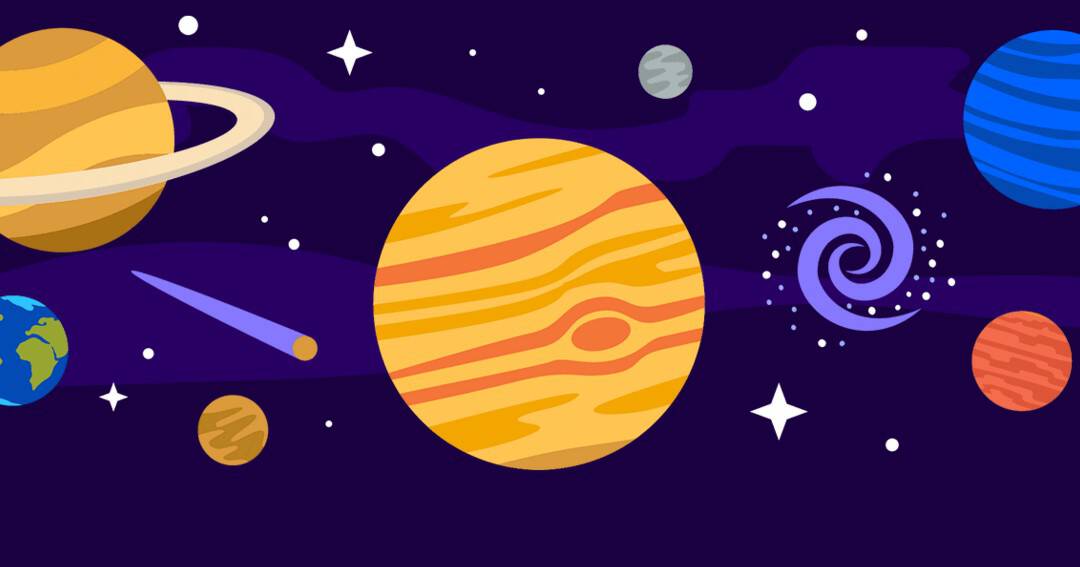The heliocentric system of the world (named after Helios, the ancient Greek solar deity) proposes that the Sun is the central celestial body around which the Earth and other planets orbit.
The geocentric system (derived from the ancient Greek word “geia” meaning “earth”) suggests that our planet Earth is at the center of the universe. This theory, although flattering for us humans, has been proven to be completely incorrect through further research. Interestingly, many great scientists of ancient Greece, including Pythagoras, Aristotle, Plato, and Ptolemy, were proponents of the geocentric model.
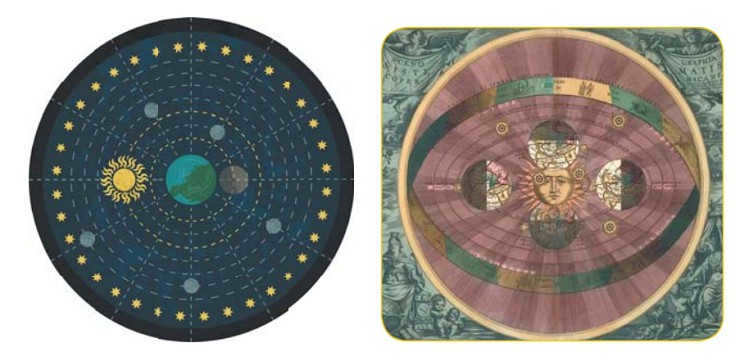
The geocentric system of the world was challenged by the heliocentric system during ancient times and eventually gained popularity in the 16th and 17th centuries.
In the heliocentric system, the Earth rotates on its axis for one sidereal day and simultaneously orbits around the Sun for one sidereal year. The Earth’s rotation is responsible for the apparent movement of the celestial sphere, while its orbit around the Sun causes the Sun to move among the stars along the ecliptic.
Origins of the ancient Greeks’ belief in a heliocentric universe
The concept of a heliocentric universe was first introduced by Aristarchus of Samos, a philosopher from the Pythagorean school, in the early 3rd century BC. However, in the Hellenistic world, geocentrism, which was based on the philosophies of Aristotle and the planetary theory of Ptolemy, became the prevailing belief after the 2nd century AD.
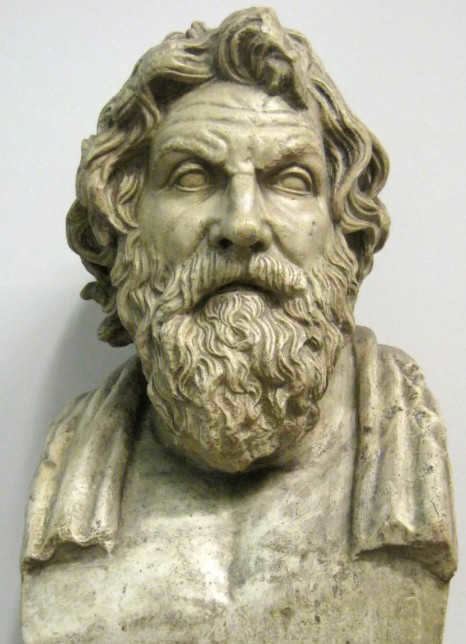
Ancient knowledge resurfacing
In the early days of the Renaissance, philosopher Nicholas of Cusa provided evidence of the Earth’s mobility. Leonardo da Vinci also discussed this topic. However, it was only in the 16th century that heliocentrism was fully revived. Polish astronomer Nicolaus Copernicus developed a theory of planetary motion around the Sun based on the Pythagorean principle of uniform circular motion. Copernicus still believed in the existence of celestial spheres that carried the planets. Thus, the motion of the planets around the Sun was explained by the rotation of these spheres around their axes.
The Prohibition That Lasted
One individual who significantly advanced the heliocentric ideas was the German astronomer Johannes Kepler. Simultaneously, on the opposite side of Europe, in Italy, Galileo Galilei also pursued this line of research. However, the Church’s persecution hindered the progression of astronomy for a considerable period of time.
Why is an incorrect theory important?
In today’s understanding, we acknowledge that the heliocentric theory is incorrect and that the Sun is not positioned at the center of the universe. However, this theory played a crucial role in establishing the parameters of the planetary system and uncovering the laws of planetary motion. The heliocentric theory ultimately led to the development of classical mechanics and the discovery of the law of universal gravitation. Additionally, heliocentrism paved the way for stellar astronomy, where stars are recognized as distant suns, and expanded our understanding of the infinite Universe through cosmology. Moreover, the scientific debates surrounding the heliocentric system played a significant role in separating science from religion, ensuring that arguments based solely on religious scripture were no longer considered in scientific discussions.
List of the top 15 amazing astronomy books:
- “Understanding the Mysteries of the Cosmos: A Comprehensive Guide to Astronomy,” Frank Wilczek
- “Unraveling the Universe: Exploring the Secrets of the Cosmos,” Steven Weinberg
- “Journey through the Stars: The Fascinating Science Behind Interstellar Travel,” Kip Thorne
- “The Enigma of the Night Sky: Unveiling the Secrets of Darkness,” Vladimir Reshetnikov
- “The Hidden Side of Space: Exploring the Mysterious Universe,” Vladimir Surdin
- “Astrophysics Unveiled: A Captivating Journey through the Cosmos,” Neil Degrasse Tyson
- “From Darkness to Light: The Birth of Stars and the Origins of the Universe,” Emma Chapman
- “Unveiling the Universe: Answering 333 Questions about the Cosmos,” Stefan Deiters
- “Cosmic Wonders: Tales of the Universe Passed Down to Future Generations,” Hubert Reeves
- “Cosmos Explored: Delving into the Secrets of the Universe,” Harald Lesch
- “There’s a lot happening inside a black hole! A Space traveler explains the cosmos,” Ulrich Walter
- “The condensed version of the universe,” Stephen Hawking.
- “Gigantic celestial bodies. Urban-sized stars,” Sergei Popov.
- “The entirety of space and time,” Carl Sagan.
- “Charting the vast expanse of the universe,” Priyamvada Natarajan.
Top astronomy publications
Within our compilation of literature on astronomy, we have incorporated well-known scientific pieces by renowned astrophysicists, investigative examinations of worldwide space initiatives and schemes, personal accounts and narratives of astronauts.

- Release date: 2015
- Language: English
- Other works by the writer: "Foundations of Existence: 10 essential concepts regarding the composition of the cosmos"
Throughout history, thinkers, artists, and scientists have pondered the question of whether beauty truly reigns supreme in the world. In his captivating book, adorned with stunning illustrations, Nobel Prize laureate Frank Wilczek delves into the subject of the universe’s beauty and scientific concepts. With each turn of the page, Wilczek takes us on a journey, exploring the evolution of beauty and symmetry in physics, from the ancient Greek philosophers to the modern theory of unifying interactions and its potential future developments. Along the way, he introduces us to the intellectual giants who have shaped our understanding of the world, including Pythagoras, Plato, Newton, Maxwell, and Einstein. Moreover, Wilczek highlights the contributions of Emmy Neuter, who derived conservation laws from symmetries, as well as the remarkable physicists of the 20th century. In contrast to many popular science writers, Wilczek fearlessly delves into the realm of equations, effortlessly explaining complex concepts and leaving us in awe and amusement.

2. “Elucidating the Universe”, Steven Weinberg
- Publication Year: 2015
- Language of Origin: English
- Additional Works by the Writer: “The First Three Minutes”
This book, authored by the esteemed physicist and Nobel Laureate in Physics, Dr. Steven Weinberg, offers a captivating and comprehensive account of the history of science. It serves as a groundbreaking exploration of how scientific knowledge has evolved, transforming from a mere accumulation of facts into a sophisticated system for understanding the world around us. Dr. Weinberg, one of today’s most prominent intellectuals, guides readers on an enthralling journey that spans from the ancient Greeks to the present day. Along the way, he delves into the scientific advancements that took place in the Arab and European world during the Middle Ages, the revolutionary discoveries of the sixteenth and seventeenth centuries, and the pivotal contributions of visionaries such as Newton, Einstein, and the developers of the Standard Model, gravity, and string theory. This book is a must-read for anyone with an interest in the history and current state of science, as well as its future trajectory.

Kip Thorne, a renowned scientist and advisor to Christopher Nolan’s hit film “Interstellar”, delves into the scientific realm in his book, providing a comprehensive explanation of the astounding concepts of gravity, black holes, the fifth dimension, and other phenomena that are vividly depicted in the movie. This captivating book is a must-read for anyone with a passion for physics, space exploration, natural science, and gaining a deeper understanding of the intricacies of our universe. It is also the perfect companion for those left with lingering questions after experiencing the mind-bending journey of “Interstellar”.

Why is the sky dark? This seemingly childish question has puzzled scientists for centuries. Astronomer Vladimir Reshetnikov delves into this question and explores the fascinating world of brilliant scientists, the history of science, remarkable hypotheses, and modern cosmological theories in his book. The book focuses solely on this simple question and takes readers on a journey through time and space.
Throughout the centuries, scientists have grappled with the mystery of why it is dark at night. Reshetnikov reveals that this question is intricately linked to the fundamental structure of our universe. Is the universe finite or infinite? Is it expanding? What is it made of? These are just some of the questions that scientists have sought to answer in their quest to understand the darkness of the night sky.
The book provides a detailed exploration of the observational facts that underpin modern cosmology. It also delves into the history of these discoveries, shedding light on the progress made by scientists throughout the years.

In our world, there are still more mysteries in the darkness than in the light. Presently, astronomers possess the ability to answer questions about the birth and death of stars, as well as the position of our Milky Way galaxy in the universe. However, how does the hidden, “dark” side of the Moon differ from the visible side? What lies within black holes? Can we physically interact with dark matter and how can we detect dark energy? The writer elucidates why the study of the “dark side” of the universe will become the main focus of astrophysics in the near future.
This book will captivate you with its exploration of astronomy – it contains a multitude of captivating illustrations, which are just as enthralling as the enigmas of the universe.
Five reasons to give it a read:
The author of this book is the renowned astronomer Vladimir Surdin.
Perfect for individuals who are just starting to explore the field of astronomy, as well as those who have been studying this scientific discipline for a considerable period of time.
Vibrant visuals that aid in the enhanced visualization of the most intricate astrophysical phenomena.


7. “The Birth of Stars: Unveiling the Origins of Space”, Emma Chapman
Emma Chapman presents an intriguing narrative in her book, drawing from the latest advancements in astrophysics to explore the captivating tale of the first stars. These celestial giants, towering hundreds of times larger than our Sun and radiating a million times brighter, embody the mantra “live fast, die young” as their existence is characterized by powerful explosions.
Delve into the enigma of their formation, their extraordinary characteristics, and the invaluable insights they provide about our contemporary universe. Chapman advocates for the utilization of colossal telescopes to peer into the depths of history and uncover remnants of these remarkable stars, effectively shifting the Dark Ages of the cosmos from theoretical physics to the realm of observational astronomy.
Five Compelling Reasons to Embark on this Journey:
Emma Chapman, a prominent astrophysicist and “stellar archaeologist,” is actively engaged in the search for the inaugural stars that emerged in our universe 13 billion years ago.
This text offers readers a comprehensive understanding of the Age of Reionization, a relatively unexplored era in the cosmic timeline that marks the genesis of the universe as we perceive it today.
Within these pages, the author delves into the origin and formation of the first stars, galaxies, and black holes.
By incorporating the most recent advancements in astrophysics research, this book provides valuable insights into the cutting-edge telescopes that enable us to glimpse the remnants of long-extinct stars.
Astronomy enthusiasts of all levels will be enthralled by the author’s engaging and humorous writing style.

The cosmos is a vast and enigmatic realm, shrouded in darkness and brimming with intrigue. Is it possible for a black hole to engulf an entire galaxy? Can we generate fire on the red planet, Mars? What secrets lie hidden on the far side of the moon? Contemporary scientific knowledge has elucidated numerous cosmic phenomena, both apparent to the naked eye and beyond the reach of even the most powerful telescopes. Stephan Deiters’ book endeavors to provide straightforward and succinct answers to the most commonly asked questions about the universe, serving as a valuable resource for anyone seeking to grasp the fundamentals of astronomy and astrophysics.


10. “Cosmo-logically,” Harald Lesch
Astrophysicist Harald Lesch takes you on a captivating voyage through the cosmos, exploring both space and time simultaneously. Our journey commences at a point in time when there was nothing and no past, and concludes in the present day, where we find a vast expanse of stars, a solar system, an Earth, and countless living beings. The Universe has accomplished an extraordinary feat in bringing all of this into being. But how exactly did it achieve this? That is precisely what you will discover within the pages of this book.

11. “There’s something happening inside a black hole! An Astronaut Explores the Universe”, Ulrich Walter
What is the temperature of space? Are black holes truly black in color? Why do astronauts experience time dilation? Where might extraterrestrial life be hiding? Physics professor and astronaut Ulrich Walter presents an engaging discussion on both near and far space, as well as the nature of matter. The scientist uncovers the mysteries behind NASA’s missions to the moon that were previously shrouded in secrecy. This book delves into the wonders of space and its most astounding phenomena, starting from the Big Bang and concluding with Einstein’s theories. If you were captivated by the recent image of a black hole and the movie Interstellar, then you will likely find this book fascinating as well. Notably, it also includes a section on the phenomenon of astronauts experiencing slower aging.

- Release year: 2017
- Language of origin: English
- Other works by the writer: “The Theory of Everything. From singularity to infinity: the beginning and destiny of the universe”, “A Brief History of Time. From the Big Bang to black holes”, “God created the integers”
Mathematical discoveries that have had a profound impact on history. The rapid advancement of technology and the acquisition of new knowledge about the structure of both the visible and invisible world have compelled theoretical physicists to search for new explanations for the established order of things. Among the most fascinating topics of discussion are those surrounding space and time. Ever since the publication of the widely acclaimed book, A Brief History of Time, Professor Stephen Hawking has closely followed the advancements in astrophysics until it ultimately became necessary to bring the general public up to date on the latest developments in cutting-edge science. In the meantime, we have made significant progress in our understanding of the intricate nature of the universe. Through an engaging dialogue with the reader, employing language that is accessible to all, the author unveils the essence of quantum mechanics, time travel, black holes, and the theory of relativity. Stephen Hawking’s work consistently emphasizes the importance of the theory of everything, which we, as laypeople, often refer to as the unified field theory – the ultimate goal of modern physics.

13. “Superobjects. City-sized Stars”, by Sergei Popov
The book focuses on neutron stars – the only celestial objects that have received two Nobel Prizes in Physics, with two more anticipated. This indicates their significant importance in modern physics. Readers will gain insight into the observation of neutron stars and the fascinating characteristics they possess. Additionally, they will have the opportunity to explore the extraordinary physical phenomena associated with these superobjects. The author passionately discusses neutron stars, their observation methods, unique attributes, and recent scientific discoveries. The popularity of this field of study is evident in the two Nobel Prizes awarded for research on neutron stars. This book aims to shed light on the reasons behind the remarkable interest in these superobjects and reveal the aspects that have astonished scientists.

Number 14: "Cosmos," written by Carl Sagan
Cosmos, which was published in 1980, is a highly regarded science book consisting of 13 chapters. The book and accompanying TV series were designed to complement each other in exploring the vast development of science and civilization. Carl Sagan, an extraordinary individual, played a crucial role in both fields. As one of the first scientist-astrophysicists, he eloquently and comprehensively described the intricate processes that occur in our vast universe. Additionally, Sagan’s profound understanding of biology adds further depth to his study of the cosmos. He begins his exploration of cosmology by delving into the realm of biology, starting with small entities such as cells and DNA. Gradually, he guides us to the cosmic level, exploring comets, planets, stars, and galaxies.

15. “Map of the Universe”, by Priyamvada Natarajan
Throughout history, humans have viewed the universe as a static and frigid expanse. However, with the latest advancements in cosmology, our perception has drastically shifted. The 21st century has brought forth a multitude of cosmological enigmas, including the formation and expansion of black holes, the presence of dark matter clouds, the universe’s accelerating expansion, remnants of the Big Bang, the identification of exoplanets, and the tantalizing possibility of parallel universes. Leading the charge in this groundbreaking research is astrophysicist Priyamvada Natarajan, who is actively constructing intricate maps of the cosmos that depict the distribution of dark matter. In her book, Natarajan delves into the transformative discoveries of the past century, the scientific principles that underpin them, and the arduous journey towards accepting radical scientific theories. Additionally, she ponders the reasons behind the resistance that novel ideas regarding our universe and our place within it often face, even within the scientific community itself. Ultimately, Natarajan asserts that science, perpetually evolving and inherently incomplete, remains our most powerful tool in comprehending the wonders and mysteries of our universe.
Final Thoughts
Countless books have been written and published about the fascinating subjects of astrophysics and cosmology, yet it appears that this genre is still in its early stages. With so many revelations still waiting to be uncovered, the possibilities are endless. In our compilation, we have highlighted 15 exceptional books that are highly recommended for those who have a fondness for gazing at the celestial heavens and contemplating the structure of the universe.
Enjoyed this article? Feel free to share the link on social media – the content of “Top 15 Astronomy and Cosmology Books” could prove valuable to your friends and colleagues. If you spot any errors in the text or wish for us to expand on a specific topic within the realm of “Astronomy,” or if you have any intriguing suggestions for our editorial team, please don’t hesitate to reach out to us via the “Contact” page using any of the provided methods.
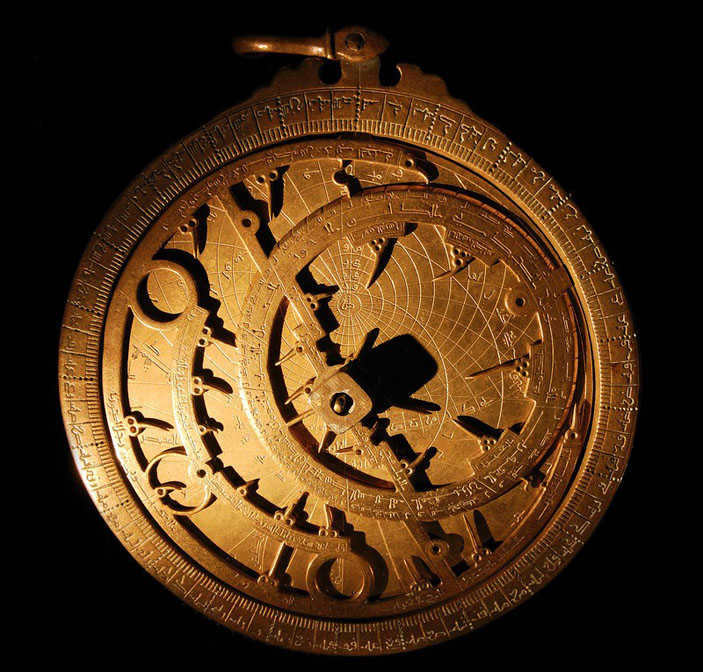
The PhD thesis titled “The Role of Astrolabe in Astronomy: From Ancient Times to the Modern Era” was successfully defended by Sergei Maslikov, the director of the Novosibirsk Planetarium, in the spring of this year. Yuri Rudoy, a physicist and member of the dissertation council, praised the thesis, stating, “I have read numerous abstracts throughout my career, but this one stands out for its captivating and eloquent writing style, resembling a novel in certain parts. With a few revisions, it could certainly be published in a reputable scientific journal like ‘In the World of Science’ or ‘Schrödinger’s Cat’.” The dissertation council was equally impressed and gladly accepted the recommendation.
Top spot in the appliance leaderboard
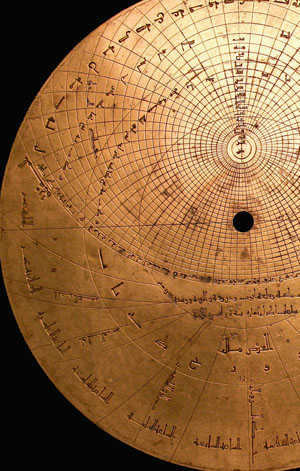
It has been seventeen years since we entered the third millennium. However, not all the achievements and discoveries of the previous millennium have been fully recognized. Can you guess which astronomical instrument was the most widely used and well-known during that bygone era? Many readers might already have the answer in mind: the telescope. However, it was only in use for a period of two hundred to two hundred and fifty years.
If we delve deeper and attempt to identify the primary astronomical instrument between the years 1001 and 2000, we would have to give credit to an instrument that is often overlooked nowadays. From the 8th century until the late 17th century, and in some places even until the 19th century, the most popular astronomical instrument in both Europe and the East was the planispheric astrolabe.
The astrolabe, derived from the Greek words “plane” and “ball,” was a tool used to convert spherical coordinates to flat surface coordinates.
There have been numerous treatises dedicated to this instrument in Arabic, Latin, and other languages. It has been depicted in paintings by artists and has been the subject of poems by poets. Astrolabes were given as gifts to kings, sultans, and other important figures. They served multiple functions, including acting as a clock, a range finder, a navigator, a calculator, a reference book for coordinates and trigonometric functions. For over a millennium, this device was utilized by scientists, explorers, merchants, clergy, astrologers, educators, and students.
Expanding a sphere onto a plane
So, what exactly is this instrument? The concept of the planisphere astrolabe was developed as far back as the 3rd century BC. Apollonius of Perga, an ancient Greek mathematician, discovered a way to represent a sphere on a flat surface – in other words, to “unfold” it. With planispheric projection, any circle on the celestial sphere, such as the zodiac, would remain a circle on the plane. Another important aspect of this projection is that angles are preserved both on the sphere and on the plane.
It is unclear when this elegant theory was translated into a physical device, specifically the first astrolabe, but by the 4th century AD, such a device already existed. Theon of Alexandria is believed to be the creator of the astrolabe.
Theon of Alexandria (circa 335 – circa 405) was a renowned Greek mathematician, philosopher, and astronomer. He is famously known as the last caretaker of the historic Library of Alexandria.
His astrolabe, along with all subsequent iterations, consisted of the following primary components:
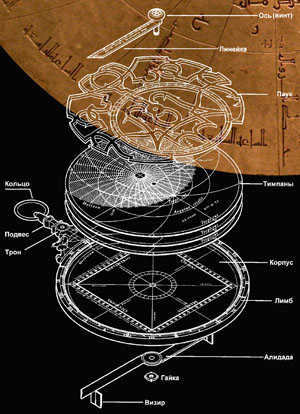
The main components of the European planispheric astrolabe include:
- The body, which features a recess and suspension, serves as the framework for the entire instrument.
- Tympans, which represent the local (horizontal) coordinate system of the observer, consist of horizon lines, meridian lines, circles of equal altitude, and azimuths. Each side of the tympanum is designed for use at a specific latitude, and there can be anywhere from one to ten tympans.
- The spider, which functions as a system of celestial (equatorial) coordinates, incorporates the pole of the world, the zodiac circle, the Tropic of Capricorn, and sometimes the celestial equator. Additionally, it includes a set of stars whose positions are indicated by pointers.
- An alidada equipped with sighting devices was used to observe the stars at night and the Sun during the day. These observations served as the foundation for time calculations and the resolution of certain astronomical problems.
The structure was secured with an axle, which in turn was held in place with either a cotter pin (referred to as a “horse” in Eastern astrolabes) or a screw (in Western instruments). According to the Ptolemaic model of the universe, the Earth (represented by the tympanum) remained stationary while the heavens (represented by the spider) were in constant motion.
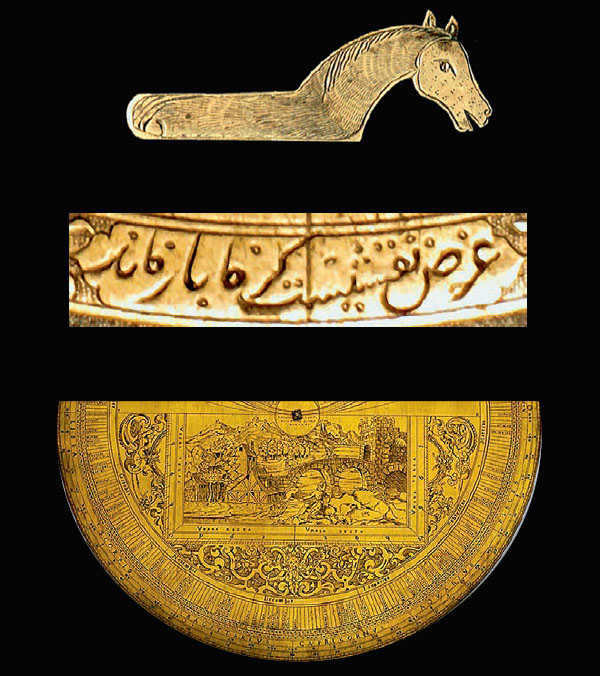

Above: The cotter pin in the shape of a horse’s head is the one responsible for securely connecting all the parts of the instrument. Center: The lines extracted from the legendary 13th-century poet Saadi’s poem “Gulistan,” which the author discovered inscribed on one of the astrolabes in the Hermitage, read, “The purpose of this creation is to endure beyond our time.” Below: The engraving on an astrolabe by the German master Johannes Pretorius can be found at the Galileo Museum in Florence.
Historians of science are currently pondering over a perplexing enigma known as the Antikythera mechanism, which was retrieved from the depths of the Aegean Sea near the island of Antikythera in 1901. Initially believed to be an astrolabe, this device proved to be far more intricate. The Antikythera mechanism contained a total of 32 gears and facilitated the calculation of no fewer than 42 astronomical phenomena. This revelation came to light when the mechanism underwent X-ray illumination. However, the most remarkable aspect is that it was constructed five centuries prior to Theon of Alexandria’s initial description of the astrolabe.
Grateful to the Arab East
The concept of the astrolabe was greatly enhanced by the Arabs, who elevated its production and usage to an exceptional level. This adaptable tool spread across the Eastern region and eventually found its way to Europe. However, not all Muslim customs were embraced, leading European craftsmen to make slight modifications to the astrolabe. Today, we can clearly distinguish between Eastern and Western versions of this instrument.
An exemplary Eastern instrument is the elaborate wooden astrolabe housed in the Oriental Department of the Hermitage. In 2015, the author had the privilege of examining this astrolabe, along with others in the Hermitage collection.
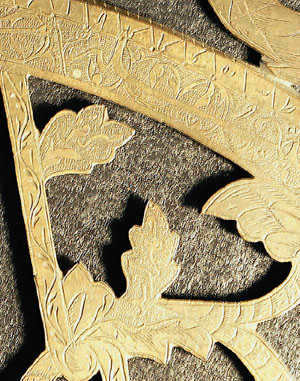
A portion of the spider from a large astrolabe at the Hermitage is displayed here. It features three leaves: the right one is purely ornamental, while the other two have the Arabic names of the stars inscribed on them.
The body and alidade of this astrolabe are constructed from wood, which is an unusual choice. Typically, astrolabes were made from brass, a durable alloy of copper and zinc commonly referred to as “eternal.” However, in this instance, the craftsman opted for wood to create a lightweight instrument of immense proportions – 435 mm in diameter. If metal had been utilized, the astrolabe would have been unmanageable.
What was the craftsman’s purpose in creating such a large instrument? He had two goals: to enhance the precision of operations and to make the astrolabe deserving of a prestigious customer. The customer is identified in the inscription on the instrument: “By order of His Excellency Agha Kanbar Ali, a devoted servant of the reigning Hakan, this astrolabe was crafted by the humble slave Muhammad Karim to gain his esteemed patronage.” Colleagues in Tehran aided in the discovery that this esteemed Agha Qanbar Ali held the position of chief treasurer at the court.
The history of each instrument is fascinating in its own right. The wooden astrolabe was produced in Iran in 1720, shortly before the Afghan invasion that toppled the last Safavid ruler, Soltan Hussein I.
The astrolabe arrived in Russia as a prize following one of the conflicts between Russia and Turkey in the late 18th and early 19th centuries. This may have occurred, for instance, when a flagship of Seyit Ali, commander of the Ottoman Empire fleet, was seized during a naval battle near Mount Athos in 1807.
The inscriptions on this astrolabe are predominantly in Persian and Arabic – the entire surface is adorned with calligraphy! The craftsman represented the numerical values not with digits, but with capital letters. Thus, instead of the familiar notation such as 21°45′, he spelled it out as “twenty-one degrees forty-five minutes”. This pattern is repeated throughout.
This wooden astrolabe has helped to solve a longstanding mystery – determining the meaning of the farsakh (farsang), an ancient unit of length commonly used in the Middle Ages. Previous attempts to define it relied on “natural” measurements. For instance, it was said to be the distance at which one can spot a camel’s silhouette in the desert, roughly equivalent to six kilometers. However, this definition was deemed imprecise due to variations in individual vision. Another definition stated that the sound of a drum in the desert could be heard from a distance of one farsakh. Alternatively, it was suggested that a farsakh is the distance a rider can travel at full speed without being overtaken by a horse. Estimates for the farsakh’s value ranged from 5.7 to 9.4 kilometers. Fortunately, this large wooden astrolabe has shed light on the matter.
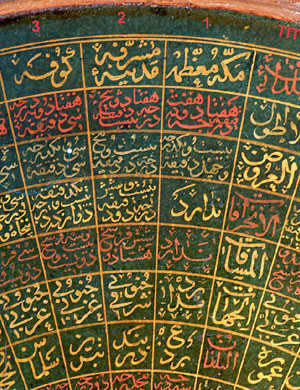
A portion of a geographical guide pertaining to a large astrolabe found in the Hermitage is provided. On the right-hand side, there are summarizing concepts such as the city, longitude, latitude, azimuth to Mecca, distance to Mecca in farsakhs, and the side of the horizon. Adjacent to these concepts, data on three cities are presented: Mecca (with a distance of zero), Medina, and Kufa.
The significance lies in the fact that an essential component of eastern astrolabes was a table featuring the coordinates of various cities. This table was inscribed on the bottom of the case, thus only becoming visible after disassembling the astrolabe, which was duly performed.
At the bottom of the case, there were discovered the coordinates of a total of 94 cities. Each city is accompanied by its name, latitude, longitude, azimuth of the direction to Mecca (also known as qibla), and the specific side of the horizon to look for the qibla. The most valuable parameter, the fifth one, is the distance to Mecca, measured in farsakhs along the former roads and caravan routes. This parameter is exceptionally rare to find in an astrolabe.
A similar instrument to ours is housed in the British Museum in London. Its data was recorded one hundred and fifty years ago. However, until now, no one has thought of such a simple task – to compare these distances with the modern distances that can easily be obtained using services like the Internet platform Google Maps.
The delight of Peter the Great
We have a greater comprehension of the European-made devices: typically, the engravings on them are in Latin. A specimen of a Western astrolabe is an apparatus produced in 1614 in Nuremberg by the relatively obscure craftsman Georg Ayerschottel. This particular astrolabe is also safeguarded in the Hermitage Museum. In the past, it was utilized by the youthful Tsar Peter.
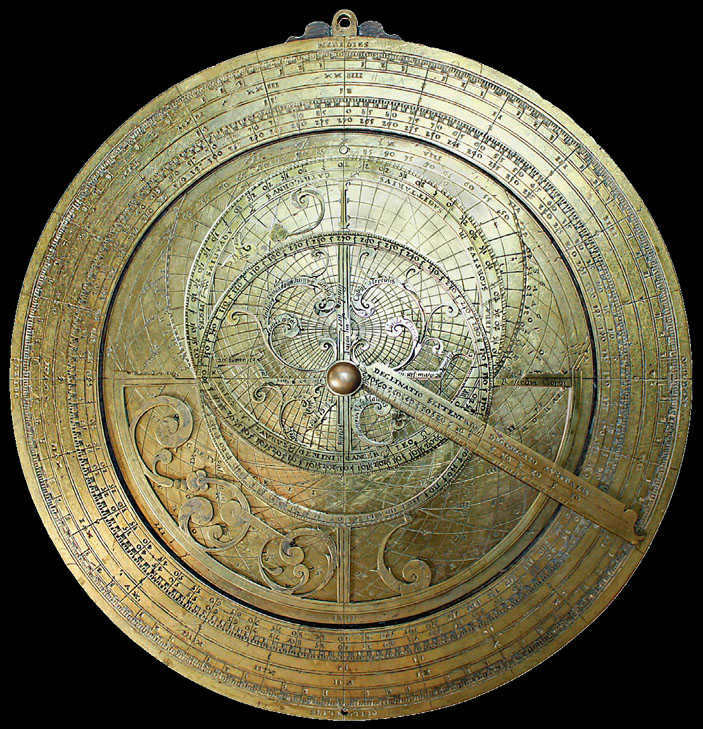
According to Russian historian Kostomarov, Peter became aware of the astrolabe through Prince Yakov Dolgoruky, who was then instructed to acquire such a device from abroad. In 1688, Dolgoruky obtained an astrolabe from France and managed to find a suitable version specifically designed for latitudes of 55 and 56 degrees.
Peter’s personal handwritten notes documenting his process of learning to operate the astrolabe have been preserved.
“When you want to determine the height of a pole (also known as polo select), and when you plan to do it and the angle at which you will measure it. The position of the Sun on the astrolabe will indicate, so record it. Then, note the declination of the Sun for that day and the angle at which you will measure it. Subtract this value from the number indicated by the Sun. The remainder, which represents the excavation, should be subtracted from 90. The remaining value represents the latitude in degrees. In winter, decrease the declination, and in summer, increase it.”
The astrolabe was created by the master based on a publication from Nuremberg that came out a year prior. It’s intriguing to note that in 1613, the star coordinates were still being recalculated from Ptolemy’s catalog, which was compiled in 137 AD, almost a thousand and a half years earlier. The author simply added a precessional shift of 21°37′ to the star longitudes. This is surprising considering that Galileo had already invented the telescope in 1604, and even earlier in 1598, the Danish astronomer Tycho Brahe had compiled an extremely accurate star catalog!
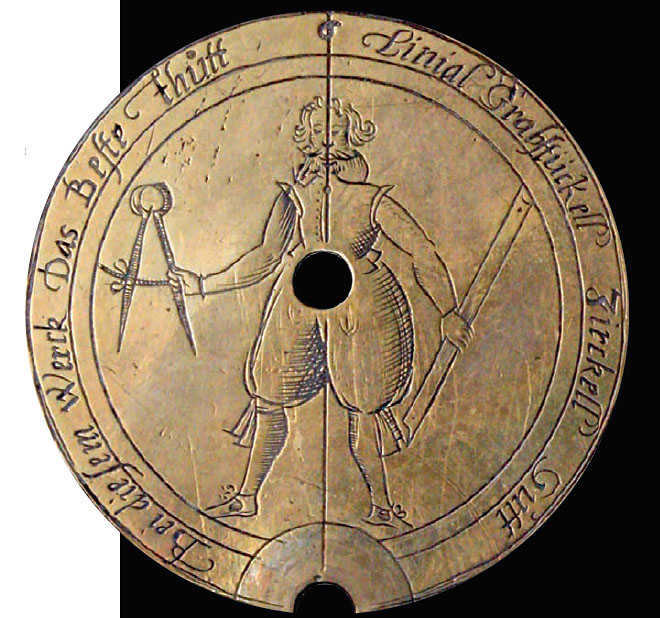
On the reverse side of Peter the Great’s astrolabe, there is a depiction of a skilled craftsman using a compass and ruler. Surrounding this image is an inscription in Old German, which roughly translates to “Superior quality is guaranteed through the utilization of precise measuring tools.”
Identity confusion
Interestingly, in Russia, the term “astrolabe” referred to a different instrument for over two centuries, from the 18th century to the early 20th century. This instrument, introduced by Peter the Great, was a geodesic device specifically designed for measuring horizontal angles during land surveying. The task at hand was vast – creating maps of the vast Russian territory. Consequently, hundreds, and later thousands, of these surveying instruments were required.
The instruments that were called astrolabes after Peter’s death are now preserved in our museums. However, their correct name is geodetic angle measuring instruments, which were the predecessors of theodolites. Therefore, Ilf and Petrov, when they had Ostap Bender say “It measures itself, if there is something to measure”, were most likely referring to geodesic astrolabes. There are only 14 surviving copies of real planispheric astrolabes, which are truly multifunctional instruments. The majority of these, nine in total, are held in the Hermitage. Three are in the Kunstkamera, one is in the Central Naval Museum, and one is in the Museum of Oriental Art (the only one in Moscow).
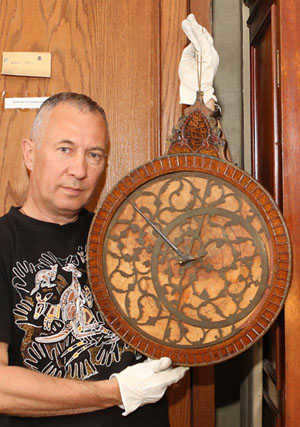
The author had the privilege of holding all of them, and I must say, the feeling is indescribable. It’s like touching a time machine – it inevitably brings to mind the craftsmen who created these masterpieces, and the famous individuals who possessed them throughout the centuries. It’s also incredibly impressive to think about the complexity and functionality of these instruments from such ancient times.
We have provided a detailed account of one of the astrolabes found at the Oriental Museum, accompanied by the expertise of Raja Sarma, an Indian researcher specializing in scientific instruments from Lahore, India. The city of Lahore was home to a lineage of skilled craftsmen who dedicated themselves to this craft for many centuries. Our comprehensive 24-page analysis of the astrolabe in Moscow, conducted in collaboration with Sarma, has brought to light several previously unexplored aspects of this instrument.
Art, auctions, and the problem of theft
Many of the world’s museums now offer their collections online, providing virtual access to art and artifacts from around the globe. One notable example is the Science Museum at Oxford, which boasts the largest collection of astrolabes. With 136 intricate instruments, each accompanied by detailed descriptions and images, viewers can explore these fascinating devices. However, one crucial piece of information seems to be missing from the catalog: the dimensions of the astrolabes. It remains unclear whether this omission is an oversight by the catalog compilers or a deliberate choice.
In recent years, wealthy Arab countries have shown a growing interest in acquiring ancient artifacts. In 2008, the Museum of Islamic Art was established in Doha, the capital of Qatar, a small yet prosperous oil-rich nation. The Arab sheikhs spared no expense, hiring top architects and acquiring valuable collections through auctions. Among these acquisitions was a collection of astrolabes, painstakingly assembled over many years by American collector Leonard Linton. The museum now proudly displays around 40 astrolabes, showcasing the beauty and historical significance of these remarkable instruments.
It would be unfair to say that all astrolabes are solely scientific instruments. In fact, there are some astrolabes that can be considered true works of art. Take, for instance, the astrolabes crafted by Johannes Pretorius, a master from sixteenth-century Germany. The engravings on his astrolabes are incredibly intricate and captivating. They are akin to fine paintings, attracting the attention of collectors and art enthusiasts alike.
Unfortunately, the allure of these antique instruments has also attracted the attention of criminals. In 2004, the world was shocked to learn about Anders Burius, the head of the rare books department at the Royal Stockholm Library. Burius had been stealing and selling particularly valuable copies for quite some time, demonstrating a high level of professionalism in his illicit activities. He would meticulously remove any trace of the stolen books from the library catalogs, making it difficult to detect his crimes.
One of Burius’ notable thefts occurred in 1999 when he stole a sixteenth-century astrolabe from Skokloster Castle. This astrolabe was later appraised to be worth an astonishing $400,000. Burius’ thieving spree finally came to an end in 2004 when he was forced to confess to his crimes. However, he could not bear the shame and tragically took his own life.
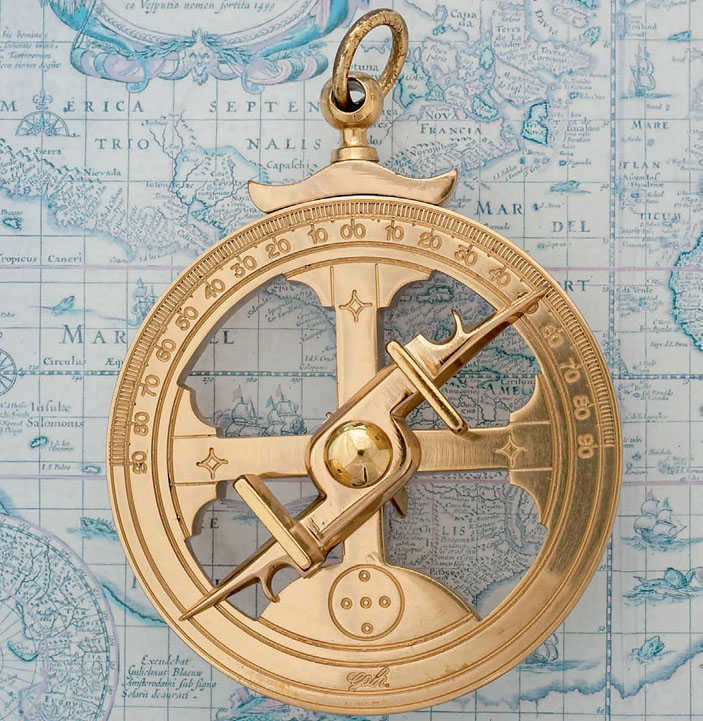
A nautical astrolabe is a specialized instrument used for measuring heights at sea during the fifteenth and seventeenth centuries.
An ongoing issue in the field is the presence of counterfeit astrolabes, which are expertly crafted replicas of original instruments. For instance, the astrolabe on display at the Moscow Museum of Oriental Art, dated 1587, is actually a copy of an older astrolabe made by Mirza Baisangur. The master himself openly admitted to creating this replica.
Even more concerning is the misrepresentation of modern astrolabes as genuine antiques. To prevent this, auctioneers consult with experts before selling rare pieces. However, there are only a few individuals worldwide who possess expertise in astrolabes (the author does not consider himself to be one of them).
What a smartphone cannot do
What insights can we gain from studying astrolabes and other scientific instruments from the past? For instance, it enables us to assess the significance of the Arab East in global scientific advancements. During my defense, Dr. Yuri Rudoy, a Doctor of Physical and Mathematical Sciences, emphasized, “In our current era, marked by clashes between civilizations, it would be valuable and relevant to popularize such works, so that people comprehend the extent to which European civilization owes its development to the Eastern, Muslim civilization. These are not opposing worlds; rather, they mutually complement each other.”

